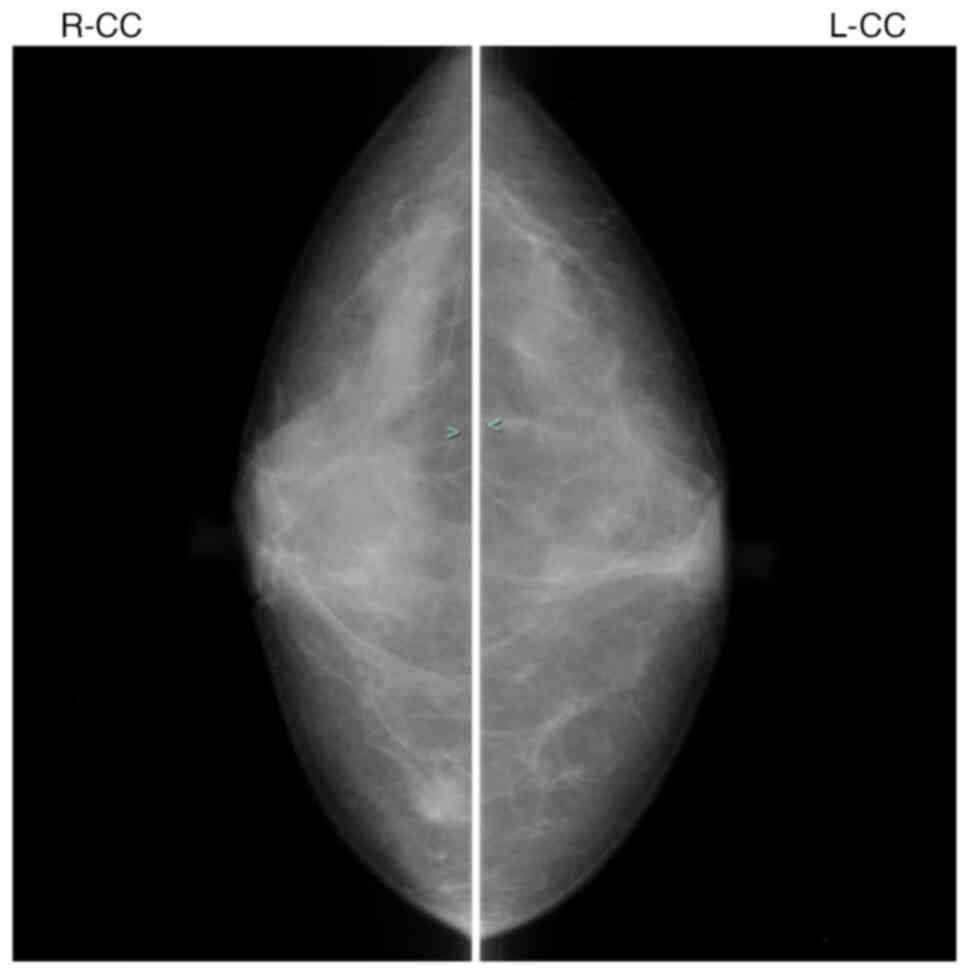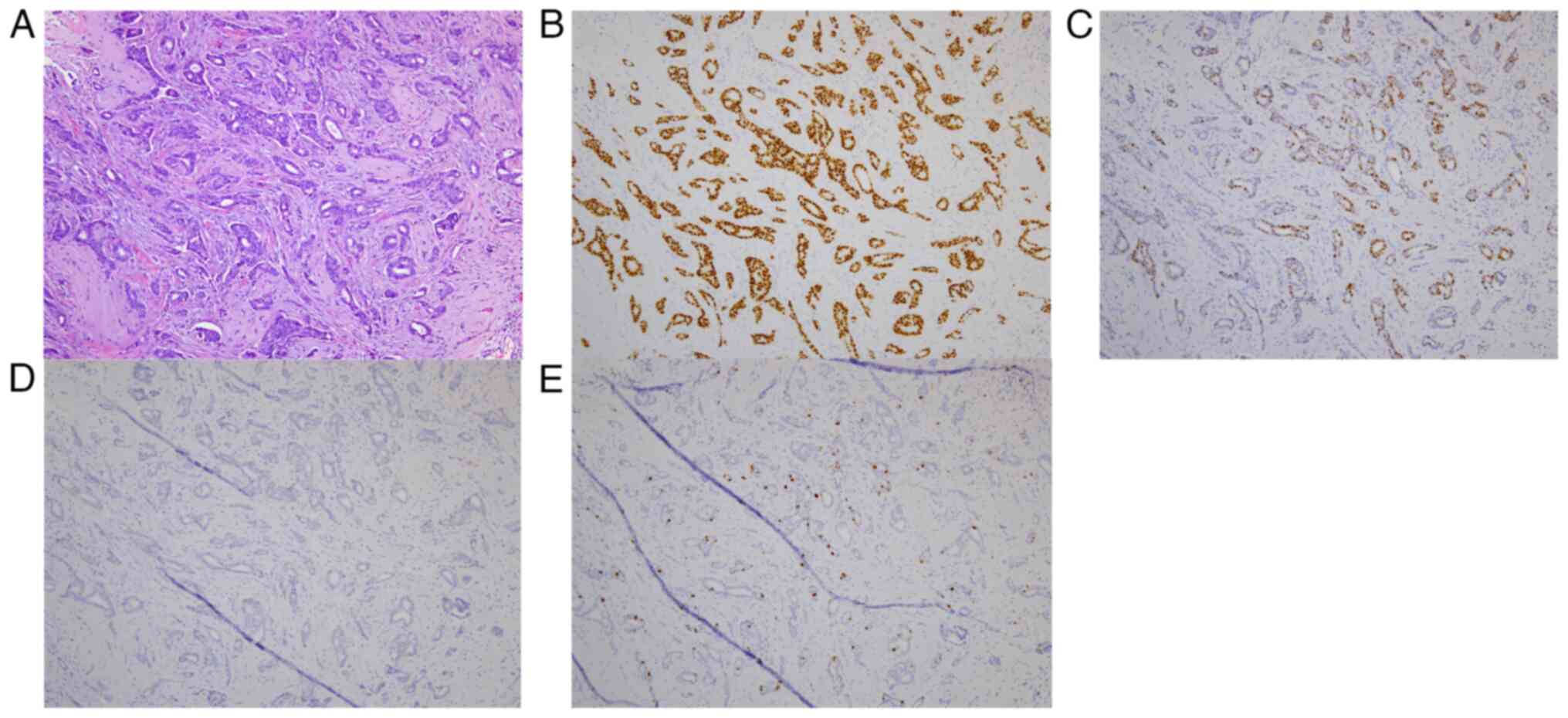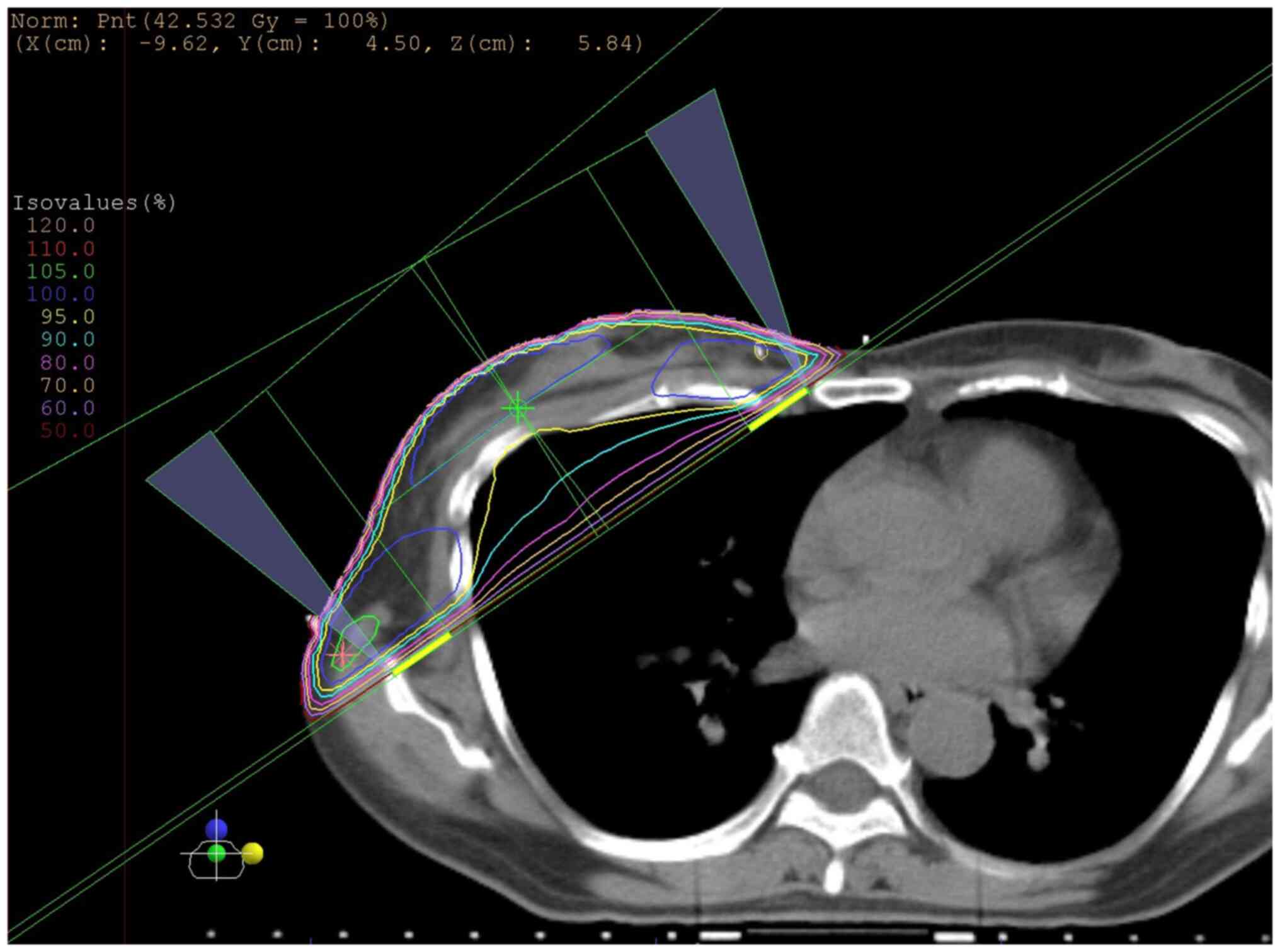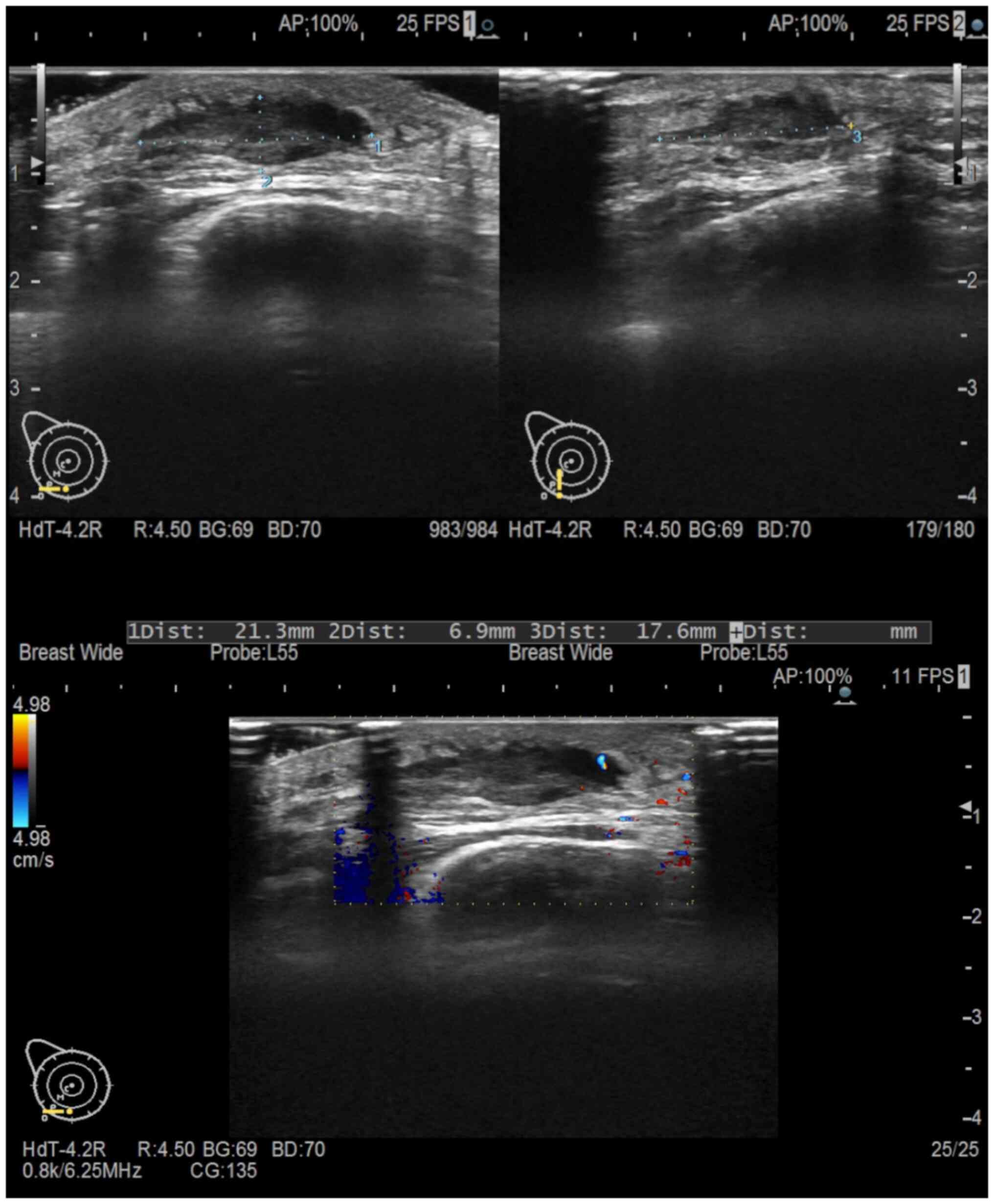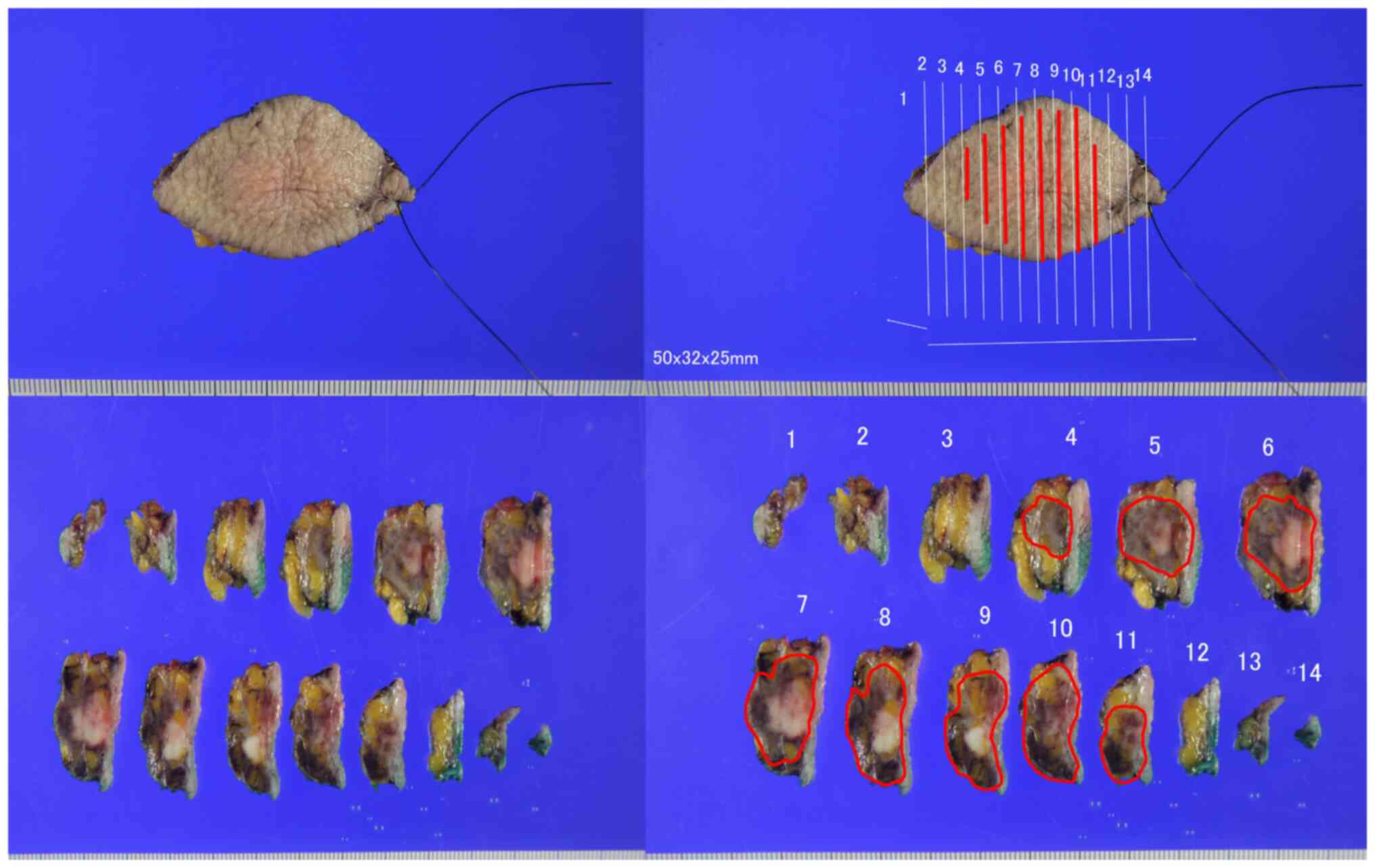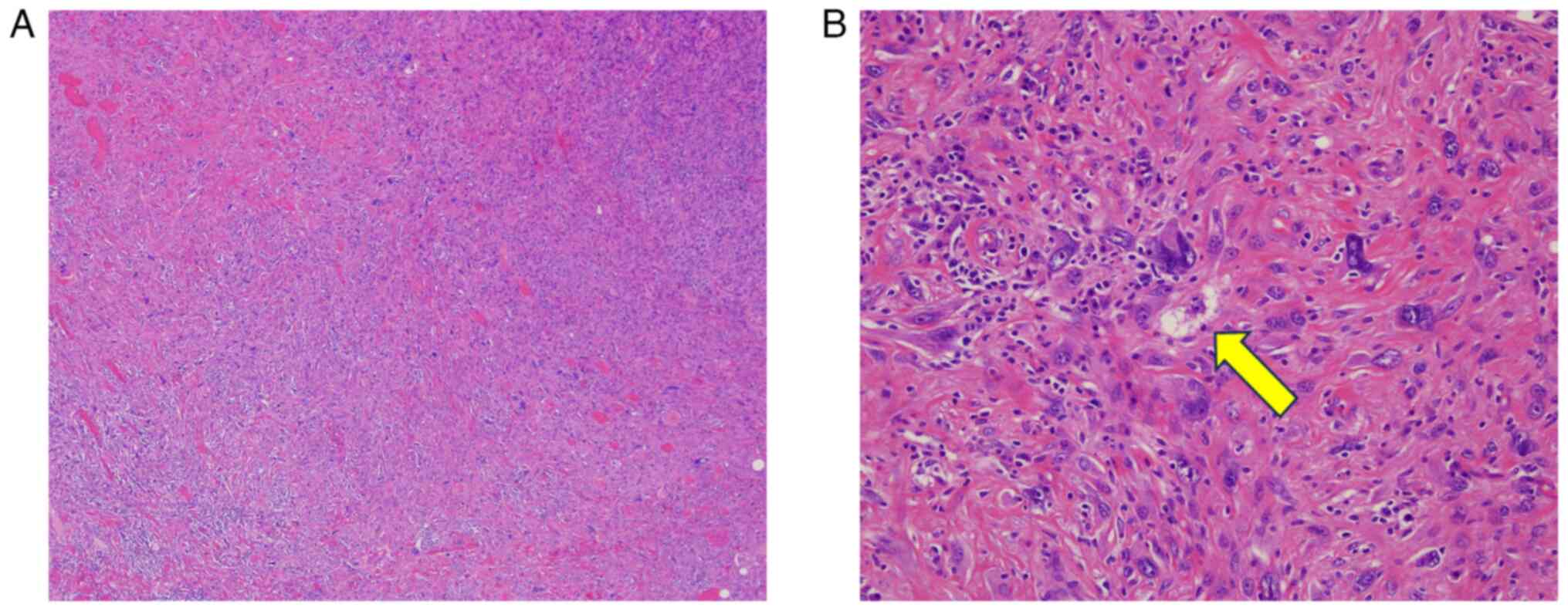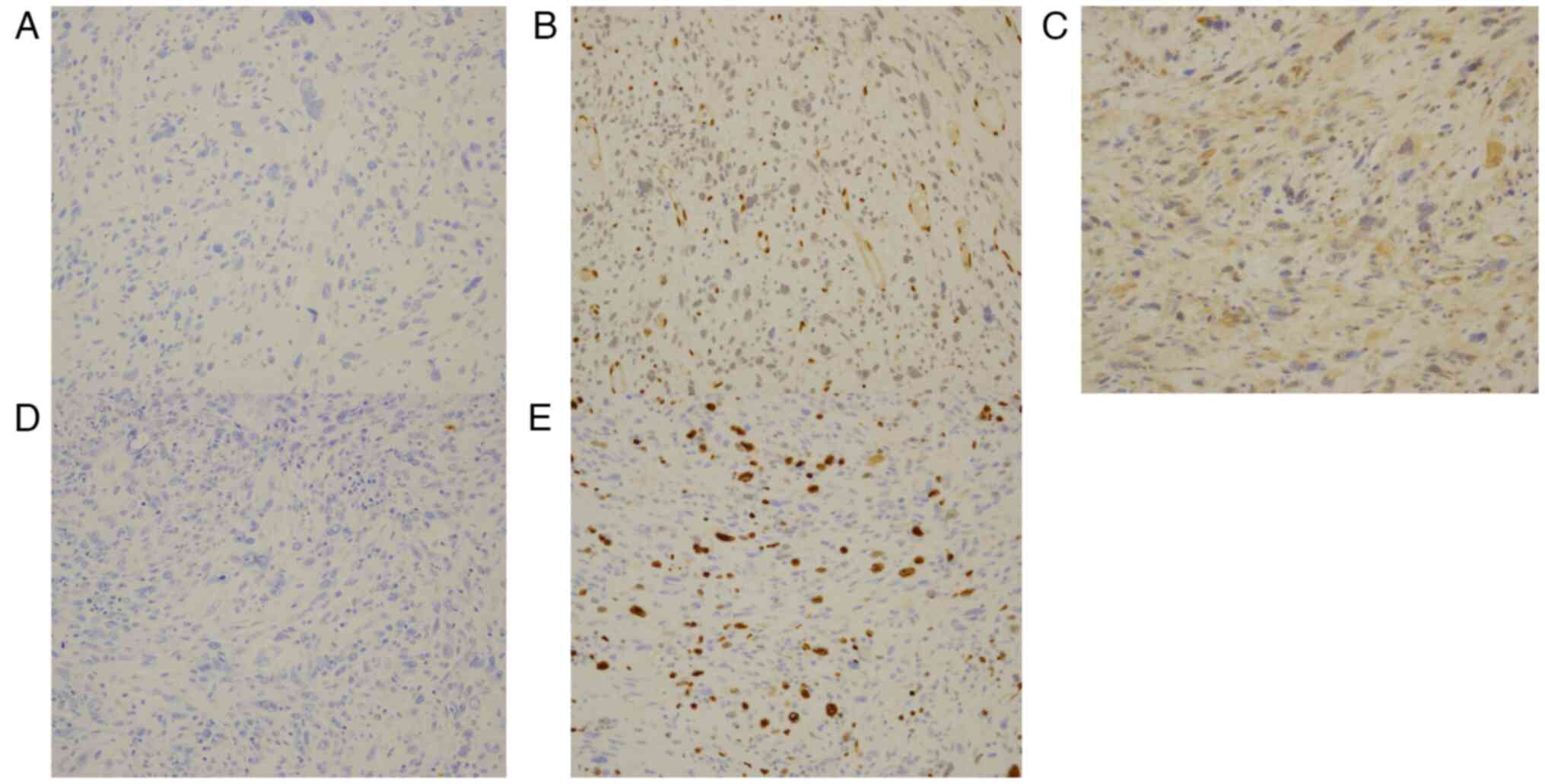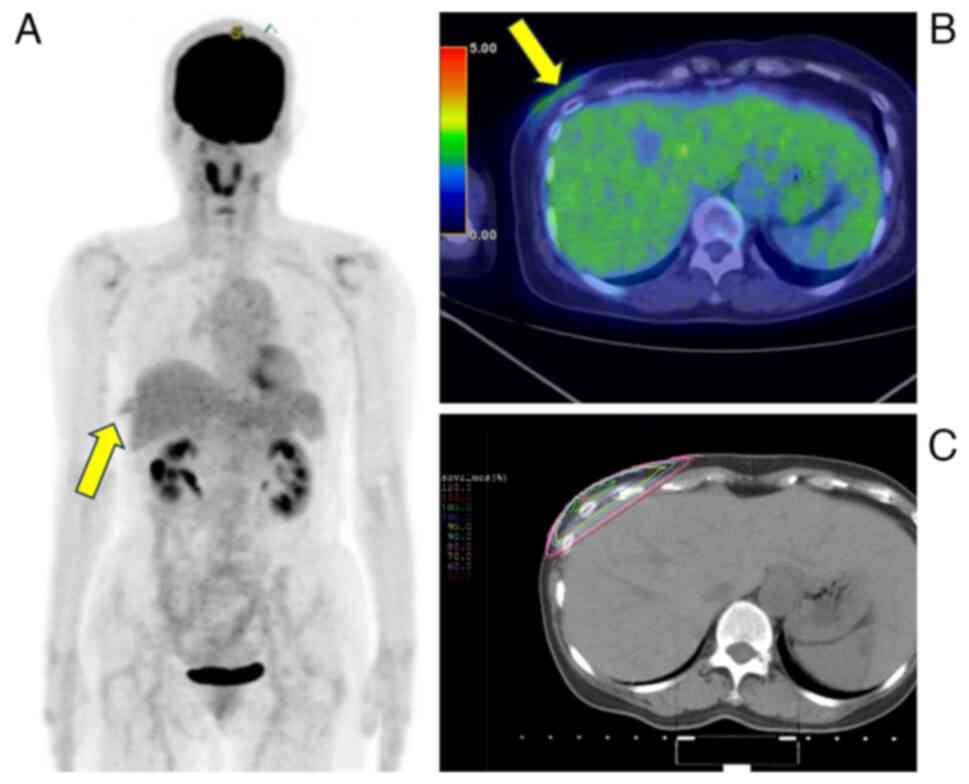Radiation‑induced pleomorphic liposarcoma after hypofractionated radiotherapy following breast‑conserving surgery: A case report and literature review
- Authors:
- Published online on: May 15, 2024 https://doi.org/10.3892/ol.2024.14457
- Article Number: 325
-
Copyright: © Watanabe et al. This is an open access article distributed under the terms of Creative Commons Attribution License.
Abstract
Introduction
In 2020, breast cancer had overtaken lung cancer to become the most prevalent form of cancer globally. Breast cancer represents 11.7% of the total number of cancer cases. Among female individuals, breast cancer constitutes 25% of all cancer cases and 16% of all cancer-related fatalities and is the leading cancer in incidence in 159 countries (1). Breast-conserving surgery is commonly used to treat early-stage breast cancer. Additionally, 50 Gy in 25 fractions of radiotherapy to the remaining breast after breast-conserving surgery can reduce the 10-year risk of recurrence and 15-year risk of breast cancer-related mortality (2). Therefore, radiotherapy is the standard of care for residual breast cancer after breast-conserving surgery. The 10-year local recurrence rates with 42.56 Gy in 16 fractions of hypofractionated irradiation and 50 Gy in 25 fractions of conventional irradiation are 6.2 and 6.7%, respectively. Since hypofractionated irradiation has shown non-inferior results to conventional irradiation (3), 42.56 Gy in 16 fractions of hypofractionated irradiation has recently been approved as an option for radiotherapy.
Cahan et al first documented the incidence of radiation-induced malignancy as a late adverse event associated with radiotherapy in 1948 (4). Since then, this information has become common knowledge. According to a previous study, the standardized incidence ratios of secondary malignancies following treatment of breast cancer are 1.08 in non-irradiated patients and 1.23 in irradiated patients (5). They reported that the irradiated group had an elevated risk of developing lung cancer, esophageal cancer, thyroid cancer, and sarcoma, which were thought to be caused by radiation. Moreover, the risk ratio for sarcoma at 10 years was 6.54, highest among all malignancies (5). Nevertheless, despite having the highest risk ratio, the 10-year reported incidence rate of radiation-induced sarcoma is negligible at 0.03–0.27% (6,7). Radiation-induced sarcomas are predominantly angiosarcomas (48.1–57.9%) (6,8). Radiation-induced liposarcomas are even rarer and accounts for 2.4% of all radiation-induced sarcomas (9). Herein, we report a rare case of radiation-induced pleomorphic liposarcoma after breast-conserving surgery and hypofractionated irradiation and a literature review.
Case report
The patient was a 63-year-old woman with no family history, history of alcohol consumption, or history of smoking. In June 2012, she underwent a breast cancer checkup at Kawasaki Medical School Hospital (Kurashiki City, Japan). She underwent a mammography and ultrasonography. Fig. 1 shows mammography. The presence of breast cancer was suspected; a pathological diagnosis of breast cancer was established based on a biopsy analysis. Contrast-enhanced magnetic resonance imaging was performed in the same month. Fig. 2 shows ultrasonography and contrast-enhanced magnetic resonance imaging. The tumor was staged as cT1bN0 cStage I. In July 2012, She was admitted to our hospital and subsequently underwent a quadrantectomy and sentinel node biopsy. She was pathologically diagnosed with papillotubular carcinoma. The invasive diameter was 7 mm with negative margins. The tumor was positive for estrogen receptor (95%) and progesterone receptor (30%) but negative for human epidermal growth factor receptor 2 (score 0); it had Ki67 index of 7.8%. A lymph node biopsy yielded negative results (0/2), and the patient was diagnosed with pT1bN0, pStage IA. The pathological and immunostaining results are shown in Fig. 3. Following surgery, in August 2012, the patient received radiotherapy to the right residual breast, with a total of 42.56 Gy in 16 fractions delivered via two oblique-entry noncontralateralized beams using a 15° wedge (Fig. 4). From September 2012, she was administered hormonal therapy for five years.
Unfortunately, in November 2020, she sought medical attention at her local hospital because she discovered hardening of the tissue beneath the skin of the right breast eight years after radiotherapy. A biopsy was performed and breast cancer recurrence was suspected. In December 2020, she was referred to our hospital; ultrasonography revealed a hypoechoic mass measuring 21×7×17 mm in the lower part of the right breast containing internal blood flow (Fig. 5). We re-evaluated the biopsy result; the pathology was less likely to be an epithelial malignancy. Therefore an excisional biopsy was performed to validate the diagnosis made in December 2020. The gross, pathological, and immunostaining results are presented in Fig. 6, Fig. 7, Fig. 8. Pathologically, the tumor contained infiltrating spindle-shaped cells without a capsule containing pleomorphic cells. Lipoblasts were also observed and tended to differentiate into adipose tissue, leading to a diagnosis of pleomorphic liposarcoma. Immunostaining of the tumor cells showed negativity for cytokeratin AE1/AE3, ERG, MDM2, and S-100 protein; the Ki-67 index was approximately 20%. In January 2021, 18F-fluorodeoxyglucose positron emission tomography/computed tomography was performed. The results and radiotherapy fields are presented in Fig. 9. Pale accumulation of 18F-fluorodeoxyglucose was detected in the right chest wall, which was interpreted as a postoperative change owing to the resection biopsy. The tumor was observed in an irradiated field and no distant metastases were observed. Owing to the close margins of the tumor, an enlargement resection involving a postoperative bed was performed in January 2021. Following extensive resection, pathology revealed no residual disease. Her last follow-up appointment was in March 2023. The patient maintained a recurrence-free survival period of three years and two months, during which no adjuvant therapy was administered.
Discussion
The initial diagnostic criteria for radiation-induced sarcoma were proposed by Cahan et al (4) and have undergone subsequent modifications over time. Currently, a more comprehensive range of criteria is employed to identify radiation-induced malignancies, encompassing more than just sarcoma (10). The criteria are as follows: i) tumor develops within the irradiated area; ii) a significant amount of time has passed since radiotherapy, preferably more than four years; iii) treated and induced tumors are histologically distinct; and iv) tissue from which the induced tumor grows is normal in terms of its metabolism and genetics before being exposed to radiation. The current case satisfied these diagnostic criteria for radiation-induced malignancy because it developed inside the irradiated area, there was a latency period of eight years, histological evidence supporting this diagnosis, and the tissue from which the tumor originated showed no aberrant signs prior to radiation exposure.
There are three subtypes of liposarcoma: i) atypical lipomatous tumor/well-differentiated liposarcoma, dedifferentiated liposarcoma, ii) myxoid liposarcoma, and iii) pleomorphic liposarcoma (11). Among them, pleomorphic liposarcoma is the least prevalent type, accounting for <5% of liposarcomas (12). Nevertheless, it is considered to be the most aggressive variant. Historically, it has been characterized by a histological makeup consisting of pleomorphic cells combined with varying amounts of lipoblasts. However, in recent years, the morphologic spectrum of dedifferentiated liposarcomas has expanded to include rare variants containing lipoblasts, called ‘homologous adipoblastic differentiation (13)’. Therefore, excluding the possibility of dedifferentiated liposarcomas, when defining pleomorphic liposarcomas, is crucial (14). Upon gross examination, pleomorphic liposarcomas often manifest as large masses that may be well circumscribed, infiltrative, or multinodular. The sliced surface of the tumor has a yellow-white coloration with potentially noticeable patches of necrosis. Microscopically, pleomorphic liposarcomas consist of a mixture of undifferentiated pleomorphic epithelial or spindle-shaped cells with varying amounts of adipocyte components. Unlike the diagnostic technique used for most adipocytic neoplasms, which does not require lipoblast identification, the presence of lipoblasts is necessary to diagnose pleomorphic liposarcomas (14). Moreover, immunohistochemistry plays a limited role in diagnosing pleomorphic liposarcomas because it exhibits a nonspecific immunological profile and demonstrates variable levels of expression of SMA, desmin, and CD34 (14). Similarly, the current case exhibited pleomorphic cells with mixed lipoblasts, which aligns with the historical criteria for diagnosing pleomorphic liposarcoma. Additionally, the immunostaining results indicated the tumor was unlike epithelial tumors, angiosarcoma and atypical lipomatous tumor/well-differentiated liposarcoma and dedifferentiated liposarcoma, based on the negative myoepithelial marker cytokeratin AE1/AE3, ERG, and MDM2, respectively. Furthermore, negative staining for S-100 protein indicates a decreased likelihood of nervous system malignancies and malignant melanomas. Although the S-100 protein can also be detected in adipocytes to help identify lipoblasts, which play a crucial role in diagnosing pleomorphic liposarcoma (14), it was negative in this case.
Yap et al reported that the cumulative incidence rate of secondary sarcomas up to 15 years was 3.2 per 1,000 patients who underwent radiotherapy and 2.3 per 1,000 patients who did not receive radiotherapy. Moreover, the incidence of secondary sarcomas was significantly higher in patients who underwent radiotherapy (P=0.001) (15). The group that underwent radiotherapy had 87 occurrences of secondary sarcomas, of which 44 were located within the irradiated area and considered radiation-induced sarcomas. Of the 44 radiation-induced sarcomas, angiosarcomas accounted for the majority (56.8%); liposarcomas were not documented (15). A large-scale study by Mirjolet et al included 125 patients with radiation-induced sarcoma. Angiosarcoma was the most common radiation-induced sarcoma, accounting for 68 (54.4%) cases. The number of liposarcoma cases was few, accounting for three cases (2.4%) (9). Pleomorphic liposarcoma, the least common subtype of liposarcoma, is regarded as quite rare among radiation-induced sarcomas.
We searched the cases of pleomorphic liposarcoma following radiotherapy in PubMed using the terms ‘pleomorphic liposarcoma’ and ‘radiotherapy’, or ‘pleomorphic liposarcoma’ and ‘radiation’. There were four reports (16–19): one case of pleomorphic liposarcoma after radiotherapy for breast cancer (16); one case after treating medulloblastoma with Gorlin's syndrome (17); one case of a lesion on the left calf after radiotherapy for epithelioid sarcoma (18); and one case of a lesion on the right buttock after radiotherapy for rectal cancer with Muir-Torre syndrome (19). These results are summarized in Table I. Including our case, two of the five cases have occurred after breast cancer treatment. At first sight, pleomorphic liposarcoma seems more likely to occur after radiotherapy for breast cancer. However, this can be a result of the high incidence of breast cancer and its favorable prognosis. Consequently, a substantial number of cases can be monitored for at least several years following radiotherapy, which may have contributed to the rise in detecting rare cases.
Systematic reviews have indicated poor prognosis of radiation-induced sarcomas, with a 5-year overall survival rate of 27–48% (7). Prognosis is correlated with tumor size, with an average survival period of 80 months for tumors <2 cm and 20 months for tumors >5 cm (7). In this case, palpation resulted in early identification of the tumor, and subsequent diagnosis and therapy were promptly administered at an early stage, leading to a favorable outcome.
Mirjolet et al. documented that the mean dose administered to the radiation-induced sarcoma was 47.8 Gy, which is high (9). Owing to recent advancements in intensity-modulated radiation therapy and volumetric-modulated arc therapy, focusing high doses on a specific treatment area is currently feasible, which has led to increased dispersion of low doses. However, as for the occurrence of radiation-induced sarcomas, reducing the high-dose volume can be effective even if the low-dose volume increases. Furthermore, radiation-induced sarcomas are also observed after hypofractionated irradiation for the breast. Veiga et al. found that the risk ratio for overall sarcoma in the hypofractionated group was 1.3 (95% confidence interval: 0.3–6.3) compared with the standard fractionated group (P=0.73), indicating no significant difference. Nevertheless, the limited number of hypofractionated radiation-induced sarcoma cases resulted in an expansion of the 95% confidence interval (20). In this regard, the accumulation of cases and research on the frequency of radiation-induced sarcomas caused by hypofractionated irradiation are issues to be addressed in the future.
In conclusion, postoperative radiotherapy after breast-conserving surgery for breast cancer is an established medical practice that improves prognosis. On the other hand, radiation-induced sarcomas occasionally occur after treatment of breast cancer, partly due to the high incidence of breast cancer and its favorable prognosis. This report describes a rare pleomorphic liposarcoma that occurred after hypofractionated radiation. Thus, follow-up examination of patients with radiation-treated breast cancer is necessary for early detection of radiation-induced sarcomas.
Acknowledgements
Not applicable.
Funding
Funding: Not applicable.
Availability of data and materials
The data generated in the present study may be requested from the corresponding author.
Authors' contributions
KW collected data and drafted the manuscript. RTo and YK collected data. TM collected pathological figures. KW, RTo, YK, TM, RTa, NT and KK participated in the study design and read and approved the final manuscript. KW and KK confirm the authenticity of all the raw data. KK supervised this study. All authors read and approved the final manuscript.
Ethics approval and consent to participate
This study was approved by the Institutional Review Board of Kawasaki Medical School (Kurashiki, Japan; approval no. 6314-00). The study was conducted in accordance with the principles of the Declaration of Helsinki.
Patient consent for publication
Written informed consent was obtained from the patient for the publication of this case report.
Competing interests
The authors declare that they have no competing interests.
References
|
Sung H, Ferlay J, Siegel RL, Laversanne M, Soerjomataram I, Jemal A and Bray F: Global cancer statistics 2020: GLOBOCAN estimates of incidence and mortality worldwide for 36 cancers in 185 countries. CA Cancer J Clin. 71:209–249. 2021. View Article : Google Scholar : PubMed/NCBI | |
|
Early Breast Cancer Trialists' Collaborative Group (EBCTCG), . Darby S, McGale P, Correa C, Taylor C, Arriagada R, Clarke M, Cutter D, Davies C, Ewertz M, et al: Effect of radiotherapy after breast-conserving surgery on 10-year recurrence and 15-year breast cancer death: Meta-analysis of individual patient data for 10,801 women in 17 randomised trials. Lancet. 378:1707–1716. 2011. View Article : Google Scholar : PubMed/NCBI | |
|
Whelan TJ, Pignol JP, Levine MN, Julian JA, MacKenzie R, Parpia S, Shelley W, Grimard L, Bowen J, Lukka H, et al: Long-term results of hypofractionated radiation therapy for breast cancer. N Engl J Med. 362:513–520. 2010. View Article : Google Scholar : PubMed/NCBI | |
|
Cahan WG, Woodard HQ, Higinbotham NL, Stewart FW and Coley BL: Sarcoma arising in irradiated bone: Report of eleven cases. 1948. Cancer. 82:8–34. 1998. View Article : Google Scholar : PubMed/NCBI | |
|
Grantzau T and Overgaard J: Risk of second non-breast cancer among patients treated with and without postoperative radiotherapy for primary breast cancer: A systematic review and meta-analysis of population-based studies including 522,739 patients. Radiother Oncol. 121:402–413. 2016. View Article : Google Scholar : PubMed/NCBI | |
|
Kirova YM, Vilcoq JR, Asselain B, Sastre-Garau X and Fourquet A: Radiation-induced sarcomas after radiotherapy for breast carcinoma: A large-scale single-institution review. Cancer. 104:856–863. 2005. View Article : Google Scholar : PubMed/NCBI | |
|
Sheth GR, Cranmer LD, Smith BD, Grasso-Lebeau L and Lang JE: Radiation-induced sarcoma of the breast: A systematic review. Oncologist. 17:405–418. 2012. View Article : Google Scholar : PubMed/NCBI | |
|
Di Lalla V, Tolba M, Khosrow-Khavar F, Baig A, Freeman C and Panet-Raymond V: Radiation-induced sarcomas of the breast: A review of a 20-year single-center experience. Cureus. 15:e380962023.PubMed/NCBI | |
|
Mirjolet C, Diallo I, Bertaut A, Veres C, Sargos P, Helfre S, Sunyach MP, Truc G, Le Pechoux C, Paumier A, et al: Treatment related factors associated with the risk of breast radio-induced-sarcoma. Radiother Oncol. 171:14–21. 2022. View Article : Google Scholar : PubMed/NCBI | |
|
Khanna L, Prasad SR, Yedururi S, Parameswaran AM, Marcal LP, Sandrasegaran K, Tirumani SH, Menias CO and Katabathina VS: Second malignancies after radiation therapy: Update on pathogenesis and cross-sectional imaging findings. Radiographics. 41:876–894. 2021. View Article : Google Scholar : PubMed/NCBI | |
|
Fletcher CDM; World Health Organization and International Agency for Research on Cancer, : WHO classification of tumours of soft tissue and bone. 4th edition. World Health, Lyon Organization classification of tumoursIARC Press; pp. 4682013 | |
|
Oliveira AM and Nascimento AG: Pleomorphic liposarcoma. Semin Diagn Pathol. 18:274–285. 2001.PubMed/NCBI | |
|
Mariño-Enríquez A, Fletcher CD, Dal Cin P and Hornick JL: Dedifferentiated liposarcoma with ‘homologous’ lipoblastic (pleomorphic liposarcoma-like) differentiation: Clinicopathologic and molecular analysis of a series suggesting revised diagnostic criteria. Am J Surg Pathol. 34:1122–1131. 2010. View Article : Google Scholar : PubMed/NCBI | |
|
Anderson WJ and Jo VY: Pleomorphic liposarcoma: Updates and current differential diagnosis. Semin Diagn Pathol. 36:122–128. 2019. View Article : Google Scholar : PubMed/NCBI | |
|
Yap J, Chuba PJ, Thomas R, Aref A, Lucas D, Severson RK and Hamre M: Sarcoma as a second malignancy after treatment for breast cancer. Int J Radiat Oncol Biol Phys. 52:1231–1237. 2002. View Article : Google Scholar : PubMed/NCBI | |
|
Arbabi L and Warhol MJ: Pleomorphic liposarcoma following radiotherapy for breast carcinoma. Cancer. 49:878–880. 1982. View Article : Google Scholar : PubMed/NCBI | |
|
O'Malley S, Weitman D, Olding M and Sekhar L: Multiple neoplasms following craniospinal irradiation for medulloblastoma in a patient with nevoid basal cell carcinoma syndrome. Case report. J Neurosurg. 86:286–288. 1997. View Article : Google Scholar : PubMed/NCBI | |
|
Orosz Z, Rohonyi B, Luksander A and Szántó J: Pleomorphic liposarcoma of a young woman following radiotherapy for epithelioid sarcoma. Pathol Oncol Res. 6:287–291. 2000. View Article : Google Scholar : PubMed/NCBI | |
|
Yozu M, Symmans P, Dray M, Griffin J, Han C, Ng D, Parry S and Wong K: Muir-Torre syndrome-associated pleomorphic liposarcoma arising in a previous radiation field. Virchows Arch. 462:355–360. 2013. View Article : Google Scholar : PubMed/NCBI | |
|
Veiga LHS, Vo JB, Curtis RE, Mille MM, Lee C, Ramin C, Bodelon C, Aiello Bowles EJ, Buist DSM, Weinmann S, et al: Treatment-related thoracic soft tissue sarcomas in US breast cancer survivors: A retrospective cohort study. Lancet Oncol. 23:1451–1464. 2022. View Article : Google Scholar : PubMed/NCBI |



